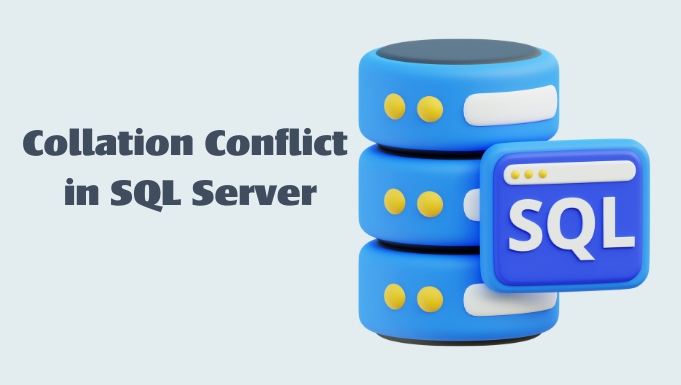SQL Server collation defines the rules for how data is sorted and compared. Understanding what does collate mean is crucial for database administrators and developers alike, especially when working with international data or performing operations that involve multiple databases.
In this article, we’ll explore what collation conflicts are, why they happen, and how to resolve them efficiently. If you’re struggling with collation issues, LogicsBuffer can help you resolve your SQL Server collation conflicts professionally, ensuring smooth database operations.
Table of Contents
What Does Collate Mean in SQL Server?
Before we dive into collation conflicts, it’s essential to address the question, what does collate mean? In SQL Server, collation refers to a set of rules that govern how data is stored, sorted, and compared. These rules include case sensitivity, accent sensitivity, and how characters are compared based on language-specific sorting conventions.

Collation is particularly important in international systems where the same letters might have different meanings or weights depending on the language. The collation setting helps SQL Server understand how to sort and compare data effectively.
The importance of collation becomes especially evident when handling multilingual datasets. For example, in some languages, accent marks may change the meaning of words entirely. Failing to configure collation correctly could lead to incorrect query results, which could ultimately affect data integrity and business outcomes.
In essence, what does collate mean? It’s the set of instructions that guides SQL Server on how to organize, interpret, and compare data. Understanding this concept is key to preventing or resolving collation conflicts in SQL Server.
Why Collation Conflicts Occur in SQL Server?
A collation conflict arises when SQL Server is asked to compare or manipulate two pieces of text data that have different collation settings. For example, if two databases or columns are using different collations, SQL Server may struggle to compare or sort data between them, leading to errors.
There are various reasons why collation conflicts occur:
- Different Database Collations: When working with databases that were created with different collation settings, you may encounter issues when querying or performing operations across them.
- Table-Level Collation Differences: Even within the same database, individual tables or columns can have different collations, leading to conflicts.
- Data Migration: Collation conflicts often arise during the migration of data between systems or databases, especially when integrating systems from different geographic regions.

These are just a few examples of where collation conflicts may arise, highlighting the importance of understanding what does collate mean when dealing with SQL Server.
Real-World Scenario of Collation Conflicts
Let’s consider a real-world scenario: You’re managing two databases, one for the U.K. and one for Spain, with different collation settings (SQL_Latin1_General_CP1_CI_AS for the U.K. and Modern_Spanish_CI_AS for Spain). When you try to join tables or compare text-based columns from both databases, SQL Server may throw a collation conflict error.
To resolve this issue, you’ll need to use the “COLLATE” clause to force both columns into the same collation, allowing SQL Server to compare them properly.
This is where understanding what does collate mean becomes critically important, as knowing how to correlate collations can save time and prevent system errors.
Common Error Messages and Their Meaning
When a collation conflict occurs in SQL Server, you may encounter errors like:
- Cannot resolve the collation conflict between “collation_A” and “collation_B” in the equal to operation.
This error often appears when performing comparisons or joins on columns with different collations. It’s SQL Server’s way of telling you that it doesn’t know how to compare the two values because they follow different collation rules.
Knowing what does collate mean in this context helps identify why the error occurred and points you in the right direction for resolving the issue.
How to Resolve Collation Conflicts in SQL Server
To resolve a collation conflict in SQL Server, the COLLATE keyword is often used. By explicitly specifying the collation, you can ensure that SQL Server can compare the data accurately.
Here’s a basic example of using the COLLATE keyword to resolve a conflict:
SELECT *
FROM TableA a
JOIN TableB b
ON a.ColumnA COLLATE Latin1_General_CI_AS = b.ColumnB COLLATE Latin1_General_CI_AS;
In this query, both columns are forced to use the same collation (Latin1_General_CI_AS), avoiding the conflict. Understanding what does collate mean helps in determining which collation to apply based on your data requirements.
Alternatively, you can modify the column’s collation permanently at the database level by altering the table schema:
ALTER TABLE TableA
ALTER COLUMN ColumnA VARCHAR(255) COLLATE Latin1_General_CI_AS;
This ensures that future queries will not encounter collation conflicts.
The Importance of Consistency in Collation Settings
The best way to avoid collation conflicts is to ensure consistency in collation settings across databases, tables, and columns. While it’s possible to fix issues as they arise, a more proactive approach can save a lot of time and frustration.
Understanding what does collate mean and planning collation settings from the start ensures that your SQL Server databases will be more robust and less prone to conflicts. For example:
- Set Collation at the Server Level: Ensure that the default collation for the server is appropriate for the regions and languages you expect to manage.
- Maintain Consistent Database Collation: When creating new databases, align their collation settings with those of existing databases to avoid conflicts later on.
- Use Uniform Column Collations: Be consistent when defining collation at the column level, especially in databases that will be joined or queried together.

Best Practices for Avoiding Collation Conflicts
Understanding what does collate mean is essential for preventing collation conflicts in SQL Server. Here are a few best practices to help avoid these conflicts:
- Standardize Collation Across Databases: When setting up databases, try to use the same collation across all systems to avoid unnecessary conflicts.
- Specify Collation in Queries: Use the COLLATE clause when necessary to ensure data is compared using the correct collation.
- Use Unicode Data Types: Consider using NVARCHAR instead of VARCHAR for international databases to avoid potential conflicts.
- Plan Data Migration Carefully: When migrating data between systems with different collations, ensure that collation settings are aligned or adjusted as needed.
How LogicsBuffer Can Help
If you’re dealing with collation conflicts or any other SQL Server issues, LogicsBuffer is here to help. Our team of experts specializes in database optimization, ensuring that your systems run smoothly and efficiently. We understand what does collate mean at a deep technical level and can resolve any collation conflicts professionally and quickly.
Contact us today to learn more about how we can assist you in optimizing your SQL Server database or resolving complex collation conflicts. Whether you’re migrating data or managing multi-language databases, LogicsBuffershas the solutions you need.
How Collation Affects SEO for Database-Driven Websites
For businesses with websites driven by SQL Server databases, collation conflicts can even affect SEO performance. Incorrect collation settings could lead to inaccurate data retrieval, broken links, or even faulty user-generated content.
For example, if a website caters to multiple languages and the collation is not set correctly, it may display content inaccurately, which could negatively impact user experience and SEO rankings. Understanding what does collate mean and applying the right collation settings ensures that content is indexed correctly by search engines, improving overall website performance.
Conclusion
Collation conflicts can be a frustrating challenge for SQL Server administrators and developers, but they are entirely avoidable with the right knowledge and practices. By understanding what does collate mean and how collation works in SQL Server, you can prevent conflicts and ensure smooth database operations.
At LogicsBuffer, we offer a range of database management services, including resolving collation conflicts, optimizing database performance, and ensuring that your systems are prepared to handle international data with ease. Contact us today to learn how we can help you resolve your SQL Server issues professionally and efficiently.
Frequently Asked Questions (FAQs)
1: What does collate mean in SQL Server?
In SQL Server, collate refers to a set of rules that govern how text data is sorted and compared. These rules include aspects like case sensitivity, accent sensitivity, and language-specific sorting conventions. Understanding what does collate mean is essential to managing how SQL Server handles different text data.
2: How do collation conflicts occur in SQL Server?
Collation conflicts occur when SQL Server is asked to compare or manipulate two pieces of text data with different collation settings. This often happens when joining tables from different databases or when comparing text across columns that have different collations. If the collations don’t match, SQL Server will throw an error.
3: How can I resolve a collation conflict in SQL Server?
You can resolve collation conflicts in SQL Server by using the COLLATE clause to explicitly set a consistent collation for columns being compared. This tells SQL Server to treat the data with the same set of rules, eliminating the conflict. Alternatively, you can permanently change the collation of columns or tables to ensure uniformity.
4: What is the COLLATE clause, and how is it used?
The COLLATE clause is used in SQL Server queries to override the default collation of columns. It’s often applied in JOIN or WHERE clauses to force columns into a consistent collation, preventing collation conflicts. For example:
SELECT *
FROM TableA a
JOIN TableB b
ON a.ColumnA COLLATE Latin1_General_CI_AS = b.ColumnB COLLATE Latin1_General_CI_AS;
5: Can I prevent collation conflicts from happening in the first place?
Yes! To avoid collation conflicts, it’s a good idea to standardize collation settings across your databases, tables, and columns from the start. You can also plan data migrations carefully to ensure that collation settings are consistent between systems. Using Unicode data types like NVARCHAR can also help avoid conflicts when dealing with international characters.
6: How do collation settings affect performance?
Collation settings can impact the performance of database queries, especially in multi-lingual databases or when dealing with large datasets. Different collation rules may affect sorting, comparison operations, and indexing. Therefore, having the appropriate collation settings is important not just to avoid conflicts, but also to ensure optimal query performance.
7: What should I do if I encounter collation conflicts during data migration?
During data migration, it’s important to align the collation settings of the source and destination databases to avoid conflicts. If you encounter issues, you can use the COLLATE clause to standardize collations for the migration process or alter the collation settings of the tables or columns involved.









